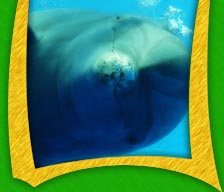|
Aquariums, oceans
or water parks ... no matter where you encounter dolphins, you will
always amaze your friends with these "fin"-tastic factoids:
- In places with a high abundance of food, pods (or
groups) can join temporarily, forming a superpod that can include
more than 1000 dolphins.
- A dolphin’s body is designed for fast
swimming; they can reach up to 21 miles per hour for short periods
of time.
- A dolphin’s head contains the melon,
a round organ used for echolocation.
- The word "Dolphin" is Ancient Greek meaning “a
fish with a womb”
- Dolphins lack an olfactory nerve and thus have no sense of smell,
but they can taste and do show preferences for certain kinds of
fish.
- Fish Whacking is one of the dolphin's hunting
methods. This happens when the dolphin uses its fluke (or long
nose) to strike a fish, stunning it and sometimes sending it flying
out of the water.
Source: Wikipedia
|
 Photo by Joyce Belloise
Photo by Joyce Belloise |
TIPS ON HELPING A STRANDED DOLPHIN:
- Carefully walk up the animal and determine that it is indeed
need of help
- Call for help. A network of experts called the United
States Marine Mammal Stranding Network has been established for
these situations. Call the nearest representative in your area.
You can also call the Florida Wildlife Conservation Commission
at 888-404-FWCC.
- When speaking with a representative describe
the animal’s
size and number of individuals involved. A description of the
animal’s
color pattern and physical characteristics is also helpful.
- Stabilize the dolphin by holding it upright so that its blowhole
is above water
- Do not push stranded dolphins back to sea
- Make the dolphin
more comfortable by digging holes in the sand for its front flippers
- While waiting for help protect the dolphin from overheating
and sunburn by keeping the animal wet.
- Avoid getting water into
the blowhole when the dolphin breathes
- Provide shade
Source: Mote Marine Laboratories
|














